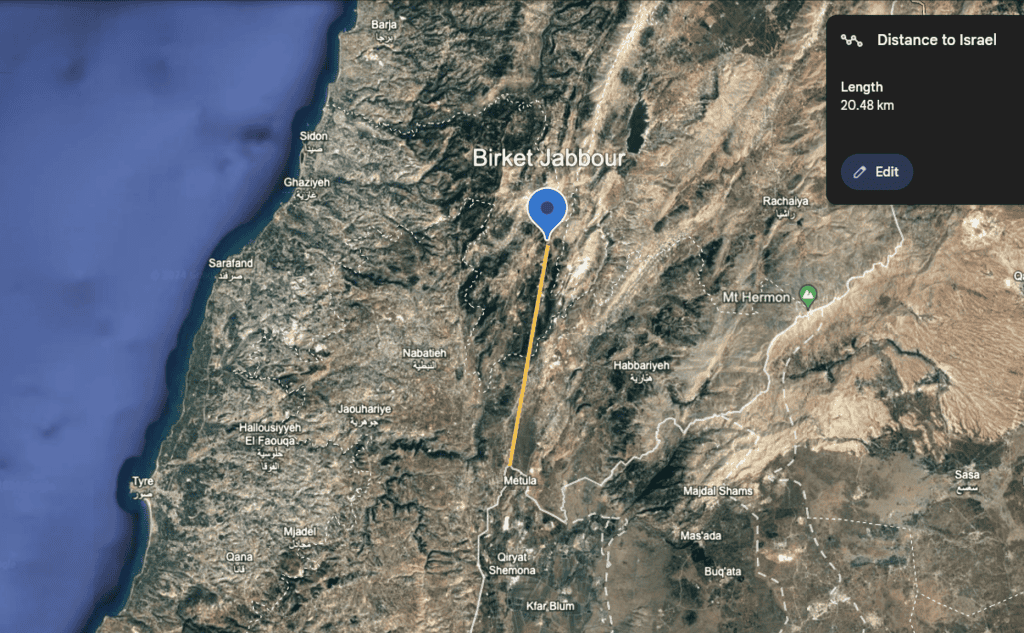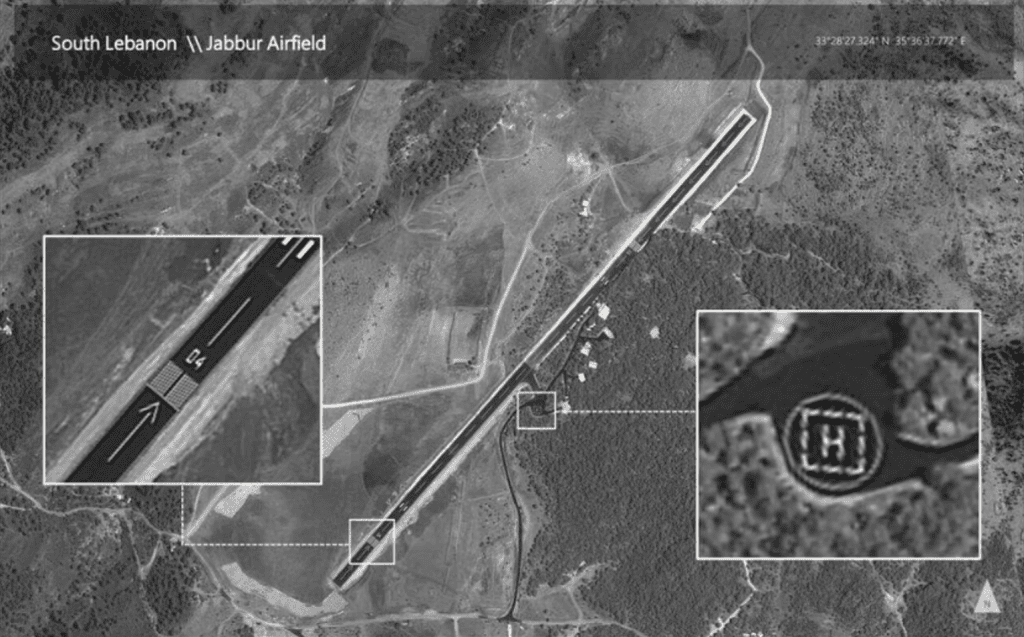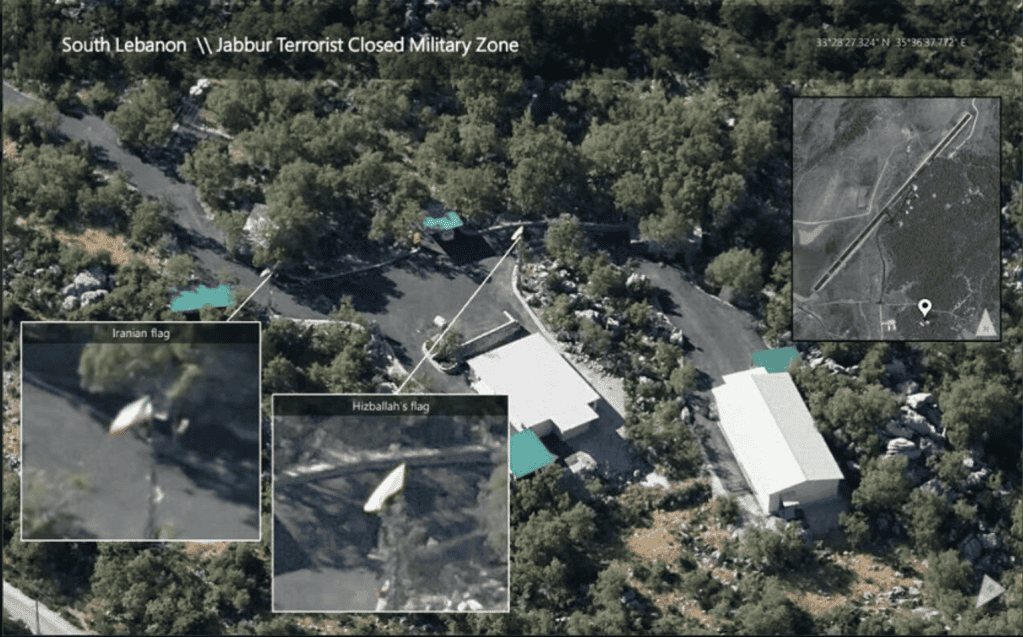On January 24, the Israel Defense Forces announced that Israeli warplanes had struck – among other targets, as part of the clashes ongoing between Israel and Hezbollah since October 8 – “a military airstrip and military infrastructure used by [Hezbollah] to direct terror attacks at the Israeli home front.” Lebanon’s state-run National News Agency (NNA) indirectly confirmed the airstrike, saying the Israel Air Force had conducted “three strikes on Birket Jabbour in the area of Jezzine, firing five rockets.” NNA Lebanon did not mention the specific nature of the Israeli strike’s target.
Birket Jabbour sits approximately 20.67km north of Metulla, Israel’s northernmost point on the Lebanon border. This distance becomes relevant in identifying the precise nature and utility of the airstrike’s target.

The air strip’s existence was first revealed by Israeli Defense Minister Yoav Galant on September 11, 2023 – during his address at Reichman University’s Counterterrorism Policy Conference. “I reveal here, for the first time,” said Galant, “pictures of an airport for terror purposes that Iran has established in Qalaat Jabbour, in the southern Beqaa, in south Lebanon.” The location identified by Galant in his speech and that identified by NNA Lebanon in its report on the January 25 Israeli airstrike are the same general area. “This is located 20km north of Metulla,” he said.

First image of Hezbollah’s airport in Qalaat Jabbour revealed by DM Galant
The Israeli defense minister then showed his audience another picture of the airport’s facilities, “where you can see two flags – the flag of Hezbollah and, unsurprisingly, the flag of Iran. On Lebanese territory, 20 km north of us.”

“In other words,” continued Galant, “the territory is Lebanese, the control [over this airport] is Iranian, and the target is Israeli.” Iran, he said, had established this airbase in Lebanon as part of its overall plan to “create a war of attrition against Israel, on all of its fronts – even as it continues to develop nuclear weapons.”
Galant said that the airport had a “long airstrip, where mid-size planes are capable of landing,” without noting the exact length or breadth of the airstrip. Other credible sources, however, put the length of the airstrip at 1.23km and its width – based on satellite footage – at “14km only.” Israeli Channel 11 (KAN 11) reported at the time that, contrary to Galant’s claim, “the small dimensions, based on estimates, would allow the launching of Iranian drones or small planes only.” The report noted that the airport’s landing strip could not accommodate cargo-planes laden with weapons originating in Iran.
Reuters at the time quoted an anonymous “non-Israeli source with knowledge of the site,” as saying that it “could accommodate large drones – some of them weaponized – built off Iranian blueprints.” The source also said that the drones launched from the site “could be used for both internal and external operational activities,” but added that the “nature and direction of the runway suggested the former were more likely,” thus confirming Galant’s assertion that the airport was intended to facilitate aerial attacks against Israel. The Israeli Defense Ministry also assessed at the time that the airport would be used by Iran to launch drones or loitering munitions at Israel during a period of fighting.
As noted above, Qalaat Jabbour is located in the southern Beqaa Valley, a short distance from an artificial pond that is locals dubbed “Birket Jabbour.” It within the administrative borders of Lebanon’s Jezzine District, between the towns of Maydoun, Kafr Houneh, and the Daraya Farm. It is a hilly area, at an elevation of about 1,000-1,200 kilometers from sea level. Hisham Jabber, a retired Lebanese Armed Forces Brigadier General, commented at the time that he “knew the area well” and that it “housed a barracks and huge training center belonging to Hezbollah,” in which the group carried out “large military maneuvers, drills of battle scenarios, and simulations of battlefields of different topographical and geographical makeup.”
Jabber said that Hezbollah has built this complex prior to 2006, and that it had been targeted during the 2006 Hezbollah-Israel war. Other sources claimed the complex was built after the war, under the supervision of Imad Mughniyeh – Hezbollah’s then-military commander. Hezbollah has reportedly even seized nearby private lands – including some belonging to Christian convents – and has forbidden their owners from entering them. Instead, the group has offered to buy the property from its owners.
Sources in nearby Kfar Houneh also said that nearby residents were well-aware that “the area of Birket Jabbour is a closed Hezbollah military zone, housing a huge complex. It’s forbidden to go near it or enter it,” though they denied hearing about the presence of an airport before.
The KAN 11 report noted, based on satellite footage, that construction on the airport portion of Hezbollah’s Qalaat Jabbour military complex had begun in November of 2022. Sattelite images show the airstrip reaching almost up to the artificial “Birket Jabbour” pond. The KAN 11 report continues, “They laid the asphalt in July [of 2023] only after leveling the area and establishing aviation infrastructure. In August, per satellite images, they finished paving the runway and built the helipad.” The final touches on the airport – “painting the take-off and landing route with aviation markings – only occurred, per the report, “two weeks prior” to Galant’s revelation.
Hezbollah issued no official comment on the airstrip at the time of Galant’s revelation or since, and indeed some Lebanese analysts with military backgrounds denied its existence at the time – even though Jane’s Defense Weekly had revealed the existence of a similar Hezbollah 670m long, 20m wide airstrip in the northern Bekaa Valley in 2015, for use by the group in operations in Syria. The most plausible use for that runway, noted the defense magazine, was “that the runway was built for Iranian-made UAVs, including the Ababil-3…and possibly the newer and larger Shahed-129.”
Unofficially, however, Hezbollah hinted to acknowledging its existence, when the group’s website Al-Khanadeq ran a report on the airport on September 12, 2023. Al-Khanadeq is Hezbollah’s most revelatory website, with access to high-ranking Hezbollah officials and military commanders. But it mixes its factual revelations with exaggerated propaganda meant to further the group’s psychological warfare against Israel and aggrandize Hezbollah’s image among its support base – to the point where it’s often hard to tell the difference.
It’s report on the airport, while it carried the taunts against Israel requisite of any report by a Hezbollah outlet, nevertheless hewed closely to the facts and framed most of its information as based on Israeli sources. Al-Khanadeq then noted that the Israeli reports had stated that “UAVs can be launched form this airport to carry out reconnaissance or attack missions.”
Indeed this may have been confirmed by the January 25 Israeli airstrike on Birket Jabbour, which came immediately after Hezbollah had announced that its fighters had “launched an attack at 11:20 AM on Thursday, 01/25/2024, with two loitering munitions” for the first time “against an aerial defense position and Iron Dome battery near…Kfar Blum,” after conducting aerial reconnaissance of the area and target with a drone.







